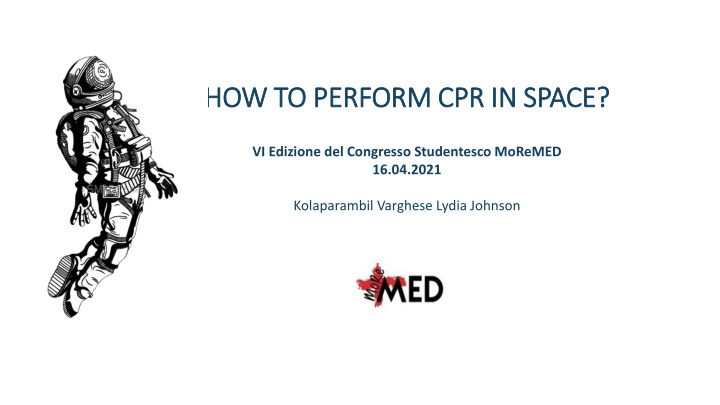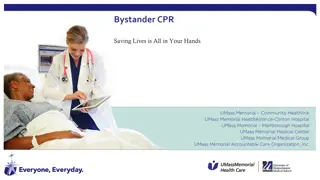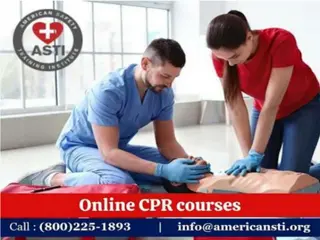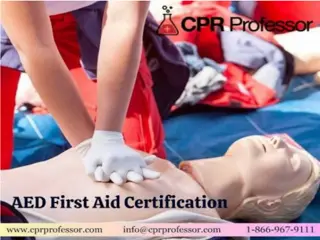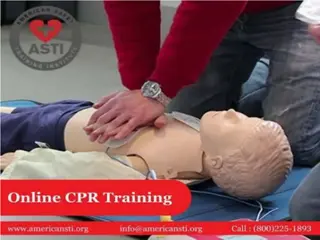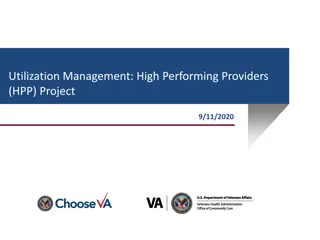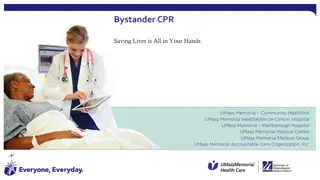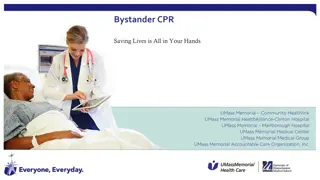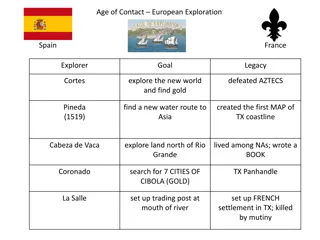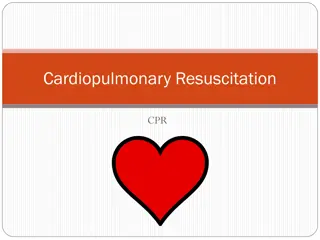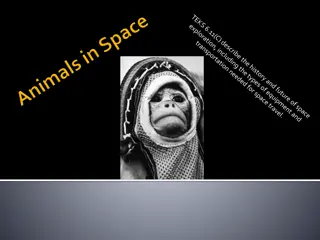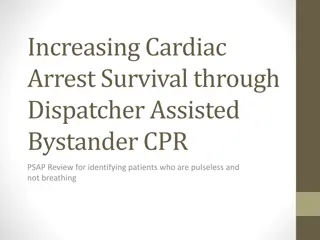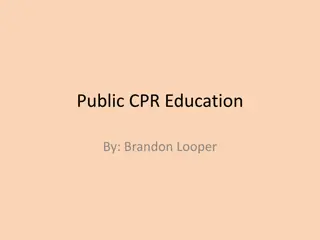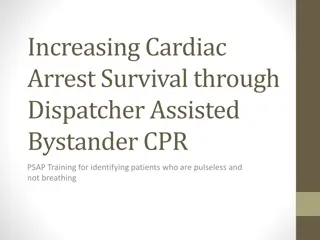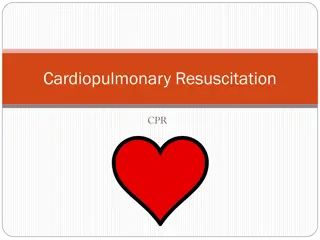Guidelines for Performing CPR in Space Missions
Importance of having CPR guidelines in space due to the critical nature of cardiac arrest, challenges faced in performing CPR in microgravity, aim of the study to address these challenges, methods used to develop recommendations, identified challenges like rescuer's weight and lack of medical expertise, and techniques for performing CPR in space including restrained and free-floating methods.
Download Presentation

Please find below an Image/Link to download the presentation.
The content on the website is provided AS IS for your information and personal use only. It may not be sold, licensed, or shared on other websites without obtaining consent from the author.If you encounter any issues during the download, it is possible that the publisher has removed the file from their server.
You are allowed to download the files provided on this website for personal or commercial use, subject to the condition that they are used lawfully. All files are the property of their respective owners.
The content on the website is provided AS IS for your information and personal use only. It may not be sold, licensed, or shared on other websites without obtaining consent from the author.
E N D
Presentation Transcript
HOW TO HOW TO PERFORM PERFORM CPR IN SPACE? CPR IN SPACE? VI Edizione del Congresso Studentesco MoReMED 16.04.2021 Kolaparambil Varghese Lydia Johnson
Introduction: Why is it important to have a guideline? Cardiac arrest is a critical medical condition with high expected morbidity and mortality Extended extra-LEO missions A single medical emergency could endanger the whole mission Without CPR, cardiac arrest will result in death of the crewmember Challenges in practicing CPR due to space environmental differences Terrestrial guidelines cannot be used during spaceflight without several modifications and specifications
Aim of the Study Address the challenges of CPR in microgravity Review of CPR guidelines Draw a plot guideline Thais Russomano and Lucas Rehnberg (December 6th 2017). Extraterrestrial CPR and Its Applications in Terrestrial Medicine, Resuscitation Aspects, Theodoros Aslanidis, IntechOpen, DOI: 10.5772/intechopen.70221.
Methods and material Task force of 27 members 15 key-words on Pubmed 88 Publications analysed through GRADE methodology Twenty-seven proposed recommendations included via the DELPHI method
Which are the challenges? The weight of the rescuer to perform chest compressions is not utilizable. Free floating Lack of medical expertise aboard
How to do CPR in Space? Five techniques: Two using straps Three in free floating
Results and recommendations Recommendation 1: CPR in microgravity SHOULD be divided into a chain of survival consisting of Basic Life Support (BLS) and Advanced Life Support (ALS) Recommendation 2: For initial BLS at the site of emergency, the Evetts-Russomano method (ER) SHOULD be applied initially. If the rescuer cannot perform adequate chest compressions with the ER method, the rescuer should switch to the Reverse-Bear-Hug method (RBH). Recommendation 3: As soon as the patient has been restrained on the Crew Medical Restraint System chest compressions SHOULD be applied using the Handstandmethod (HS) if favored by the dimensions of the spacecraft and provider height. Recommendation 4: If the application of the HS method seems impossible either the restrained CPR method using the standard OR straddling position SHOULD be applied. Recommendation 5: An chest compression device COULD be used on a restrained patient (if available). Its installation, however, should not delay high quality chest compressions.
Recommendation 6: If an automated o rescuer with extensive training in tracheal intubation is present, a second generation supraglottic airway device SHOULD be used for airway management. Recommendation 7: The tracheal intubation remains the gold standard for securing the airway if performed by a skilled provider and SHOULD be performed in that case. Recommendation 8: When tracheal intubation is attempted patient and rescuer should be restrained using the Crew Medical Restraint System. Recommendation 10: A defibrillator SHOULD only be used on a patient that is restrained to an electrically isolated and safe surface. Recommendation 11: An automated external defibrillator (AED), with long duration batteries and long shelf-life self-adhesive pads, SHOULD be stored with the emergency equipment. Recommendation 12: The AED SHOULD have a user-friendly interface, a step-by- step instruction voice for correct pads positioning and electrical shock delivery and a timing device for correct chest compressions/ventilation rate.
Recommendation 13: All crewmembers SHOULD be trained in the use of the specific AED provided during the mission. Recommendation 14: Even if survival is highly unlikely without defibrillation, CPR SHOULD start when a defibrillator is unavailable in the space vehicle, in patients who appear to be in cardiac arrest. Recommendation 15: Although the survival rate is likely to be reduced in the absence of medical skills and/or equipment for on-going medical support in the event of ROSC in microgravity, defibrillation SHOULD take place when appropriate. Recommendation 16: Venous access SHOULD ONLY be performed if more than two rescuers are present during a cardiac arrest and high-quality CPR is performed. Recommendation 17: As a first choice for the application of medication a peripheral venous cannulation SHOULD be used. Recommendation 18: When a peripheral venous access cannot be established in a patient in cardiac arrest in microgravity, the intraosseous tibial route SHOULD be used.
Recommendation 19: For intravenous and intraosseous infusion, a degassed infusion bag encased in a pressure bag SHOULD be used. Recommendation 20: In low earth orbit, telemedicine support SHOULD be consulted in the event of a cardiac arrest, when it seems feasible and the manpower for its application is present. Recommendation 21: During space exploration missions to Mars, telemedicine support will be impractical during CPR due to the communicational time-delay (3 23 min) and SHOULD only be attempted, when additional crewmembers, not involved in treating the patient, are present. Recommendation 22: The decision to terminate resuscitation SHOULD be made by the crewmember with the highest medical qualification after consultation with telemedicine support. Only if telemedicine support is unavailable or time delay prevents prompt feedback the decision has to be made by the crewmember with the highest medical qualification alone.
Conclusions Real life experience is missing Only few studies regarding airway management Studies for many other aspects of CPR such as defibrillation, drug therapy or post resuscitation care remains minimal to nonexistent. Further research is necessary
Aknowledgments and Affiliations Prof. Dr. Med. Jochen Hinkelbein Dr. Med. Steffen Kerkhoff All the other authors ESAM Space Medicine Group Universit degli studi di Perugia
